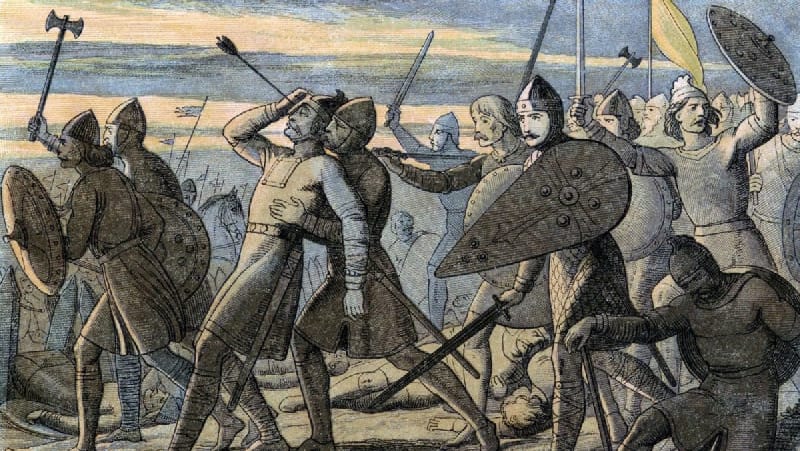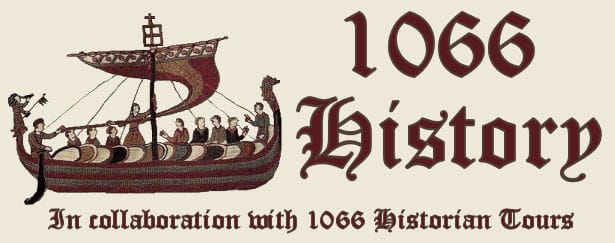What Caused the Battle of Hastings?
For any momentous event in history there will be a number of reasons why it happened when it did. When examining the causes of the Battle of Hastings, these contributory factors can be split into Long Term Causes (1002-1042), Medium Term Causes (1042-1065), Short Term Causes (1066) and a Trigger Event.

Contents
Long Term Causes 1002-1042
Medium Term Causes 1042-1065
Short Term Causes 1066 Jan-Sept
Trigger Event
Long Term Causes 1002-1042:
1. The marriage of Aethelred the Unready to Emma of Normandy, sister of Duke Richard II of Normandy in 1002.
King Aethelred wanted an alliance with Normandy as he felt that it would give him some support against the continual Viking invasions he was facing. Emma was Aethelred’s second wife and it was agreed that their children would take precedence in the line of succession. Their children, Edward, Alfred and Godgifu were half Anglo-Saxon and half Norman.
2. Conquest of Sweyn Forkbeard
When Sweyn Forkbeard became King of England in 1013, Emma and Aethelred’s children were sent to Normandy for safety. This strengthened the future King Edward the Confessor’s relationship with his Norman relatives. He was living in Normandy when the future Duke William II of Normandy was born in 1028.
3. Accession of Canute
Canute, son of Sweyn Forkbeard, became King of England in 1016. Within months of his coronation, he took the widowed Emma of Normandy as his second wife. It was now agreed that the children of Emma and Canute would take precedence in the line of succession.
4. Harthacnut’s treaty with Magnus the Good
In 1038, Emma and Canute’s unmarried son, Harthacnut, agreed a treaty with King Magnus the Good of Norway. The terms of the treaty agreed that if one of them died without an heir the other would succeed. This gave the Vikings an ongoing claim on the English throne.
Long Term Causes of the Battle of Hastings – Summary
In terms of the long term causes of the Battle of Hastings, the two marriages of Emma of Normandy are of paramount importance. The inter-marriage of Emma, of the House of Normandy, to the Houses of Wessex and Denmark ultimately led to the challenges for the English throne made by Harald Hardrada and Willliam Duke of Normandy in 1066.

Medium Term Causes 1042-1065:
1. Accession of Edward the Confessor
When King Harthacnut died in 1042, the Witan invited Edward the Confessor, son of Aethelred the Unready and Emma of Normandy, to become King. Although he had been promised the throne by Harthacnut, Magnus the Good of Norway was unable to pursue his claim to the English throne due to unrest in Denmark.
2. Rise of the Godwin family
King Edward was a virtual stranger to England, having lived in exile in Normandy for 25 years and was viewed as a foreigner. He needed the support of the English nobility, particularly the leading nobleman, Earl Godwin of Wessex. This led to the meteoric rise of the Godwin family with all male members of the family being appointed to prominent positions and Godwin’s daughter Edith becoming the wife of King Edward.
3. Exile of the Godwin family 1051
In 1051 Edward was visited by Eustace of Boulogne and his retinue. On their return journey there were brawls in Dover and a number of Eustace’s men were killed. Earl Godwin refused to carry out Edward’s order to execute those responsible. King Edward imprisoned the Earl’s youngest son, Wulfnoth, and his grandson Hakon and exiled the rest of the family. The family were reconciled with the King in 1052 after they raised an army against Edward. However, the two hostages remained in prison.
During the period of the Godwins’ exile, Edward was visited by his kinsman William Duke of Normandy. It is believed that during this visit Edward placed the two Godwin hostages in William’s care and also promised him the English throne should he remain childless. This was the basis for William’s later claim on England in 1066.
4. Harold Godwinson’s oath, sworn on holy relics
Harold Godwinson had succeeded his father as Earl of Wessex in 1053 and become chief advisor to the King. In 1064 he made a sea journey from Bosham on the south coast. The purpose of this voyage is unclear, but it is possible that he was travelling to Normandy to secure the freedom of his younger brother and nephew who had been taken hostage and sent to Normandy in 1051.
Harold was shipwrecked off the coast of Ponthieu and taken to Duke William. It is known that Harold rode into battle by William’s side and also that he secured the release of Hakon, who returned to England with him. William later stated that Harold had sworn on holy relics to support his claim to the English throne.
5. Death of Edward the Exile
Towards the end of his reign, Edward the Confessor sent emissaries abroad to see if the exiled family of King Edmund Ironside could be located. It is believed that he intended to make the eldest son, Edward, his heir. Some historians believe that Harold Godwinson may have been one of those sent on this quest. Edward the Exile, his wife Agatha, his son Edgar and two daughters Margaret and Cristina were found in Hungary. They returned to England in 1057, but shortly after returning Edward died. His son, Edgar was 6 years old at the time of his father’s death.
6. Exile of Tostig Godwinson
Harold Godwinson’s younger brother Tostig was Earl of Northumbria. In 1065 the people of Northumbria rebelled against his rule. King Edward the Confessor sent Harold north to deal with the disturbance. Harold chose to exile his brother in order to avoid further conflict and most likely to also strengthen his own position as a skilled administrator. Tostig was furious with his brother and set about gaining support from foreign leaders for an invasion to challenge Harold’s position.
Medium Term Causes of the Battle of Hastings – Summary
Edward the Confessor was a virtual foreigner in England and could not rule without the support of the Godwin family. Although he married Godwin’s daughter Edith, there were no children of the marriage. It is traditionally said that Edward refused to consummate the marriage due to his religious beliefs, however, it is equally likely that he did not want a Godwin to take the throne.
This is further evidenced by Edward’s decision to find Edward the Exile and bring him back to England. Edward the Exile was a member of the House of Wessex with a direct claim to the throne. Had he survived it is likely that he may have succeeded to the throne peacefully.
William II Duke of Normandy believed that he would succeed to the English throne based on Edward’s promise of 1051, backed by Harold Godwinson’s oath made in 1064.
Harold’s exile of his brother Tostig in order to strengthen his own position led to the alliance between Tostig and Hardrada and the subsequent invasion of the North of England in September 1066.

Short Term Causes – Jan – Sept 1066
1. Coronation of Harold Godwinson
King Edward the Confessor died on 5th January 1066. His marriage to Edith Godwinson was childless so the succession was unclear. The Witan met and decided that they did not want to be ruled by a foreign power, ruling out Harald Hardrada and William of Normandy who both had a valid claim to the throne. They also ruled out Edward the Exile’s son, Edgar, as being too young to lead the country especially in the fact of potential challenges. They therefore chose to crown Harold Godwinson King on 6th January 1066.
2. William gaining the Pope’s blessing
William Duke of Normandy learned of Harold’s duplicity around the middle of January. He saw Harold’s coronation as a deliberate betrayal of his promise to support his claim to the English throne and vowed to take it from him.
However, rather than attack England immediately, William sent envoys to the Pope in Rome. When they explained that Harold Godwinson had broken an oath sworn on holy relics, the Pope gave William his blessing and sent him a papal banner to carry into battle.
William was able to use the Pope’s backing to persuade Norman, Breton, Flemish and French nobles to join his cause. Those that contributed the most to the invasion would be given the most land once England was conquered.
3. Tostig Godwinson’s alliance with Harald Hardrada
Tostig Godwinson was determined to seek revenge for being exiled by his brother Harold. He set about forging an alliance with a foreign power in order to invade England and regain his status in the country. It is believed that he may have been turned down by William of Normandy, but he convinced Harald Hardrada that he was loved by the people of Northumberland and that they would rise up in support of their joint invasion.
Hardrada and Tostig invaded the region around the Tyne in early September before sailing south and entering the mouth of the River Humber on 18th September 1066. They sailed to Ricalli then marched north towards York. They were intercepted by an army raised by the northern earls, Edwin and Morcar.
The invasion of Hardrada and Tostig, and their success at the Battle of Fulford meant that Harold had to raise the southern fyrd and march north to deal with the Viking threat. This left the south coast unprotected.
Short term causes of the Battle of Hastings – Summary
Medieval coronations were generally held on the first religious festival following accession. The fact that Harold Godwinson was crowned just one day after Edward the Confessor’s death indicates a haste to secure the throne before any challenge could be made.
William of Normandy was a great military tactician and his decision to seek the Pope’s blessing for an invasion was a clever move. He almost certainly gained greater support for his invasion as a result of ‘God being on his side.’
The invasion of Hardrada and Tostig and the subsequent defeat of the Anglo-Saxons at Fulford meant that King Harold had to march north in haste. Although Harold’s army was successful at the Battle of Stamford Bridge and Hardrada and Tostig were killed, Harold and his men were tired and the south coast was unprotected.

Battle of Hastings Trigger Event – 28th September 1066
The Trigger event for the Battle of Hastings was the landing of the forces of William Duke of Normandy at Pevensey on the morning of 28th September 1066.
It is unclear whether William was aware of Hardrada’s invasion and Harold’s march north, or whether it was an advantageous coincidence that the south was unprotected at the time of his invasion.
However, William’s invasion meant that a battle between the Anglo-Saxons and Williams army was inevitable. Had Harold not been in the north, the battle may have taken place at a different location and may have had a different outcome. But because William’s landing was unopposed, he was able to march to Hastings, set up camp, rest his men and wait for Harold to come south.
